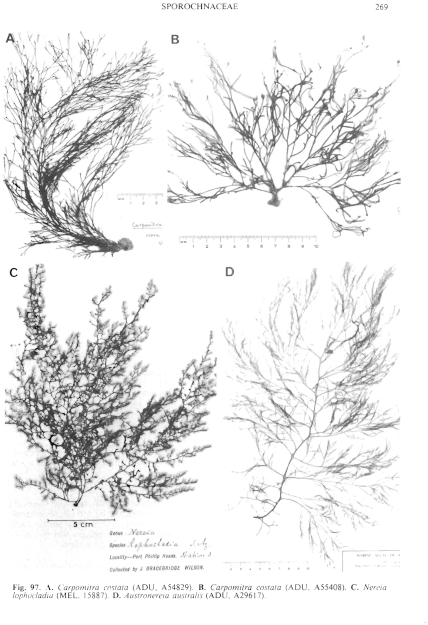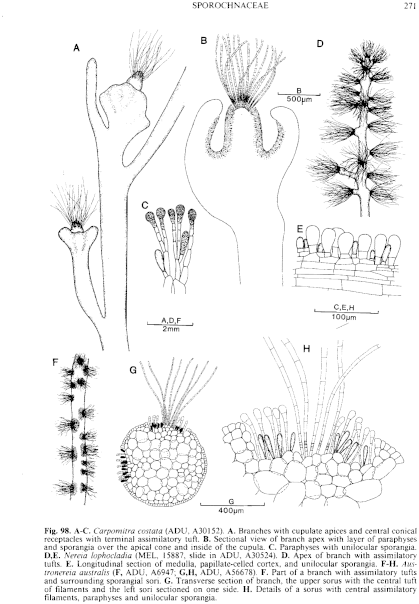|
|
|
|
|
|||||||||||
|
Electronic Flora of South Australia Species Fact Sheet
Phylum Phaeophyta – Order Sporochnales
Synonym
Nereia australis (Harvey) Harvey 1859b: 289, pl. 188. Womersley 1967: 238. Stilophora ? australis Harvey 1844b: 453.
Thallus (Fig. 97D) medium brown, usually 15–50 (–65) cm long, with one to a few percurrent axes (often basally denuded), densely branched radially with long laterals bearing shorter branches to 4 or 5 orders, with most branches covered with discrete tufts of assimilatory filaments giving a soft, tomentose, appearance; holdfast rhizoidal, 2–6 mm across and 1–4 mm long; epilithic. Growth apical, with a relatively small, convex branch meristem surmounted by a tuft of trichothallic assimilatory filaments 1–3 (–5) mm long, each with a vague meristem 2–4 cells above their base, (6–) 8–10 (–12) µm in diameter with cells L/B 6–12 above. Fronds terete, 1–2 mm in diameter below, tapering gradually to (50–) 100–250 µm in diameter near the apices, with tufts of assimilatory filaments and short laterals scattered over the branches (Fig. 98F) with smooth cortex between them. Structure haplostichous and pseudoparenchymatous (Fig. 98C), with a central medulla of elongate cells, outer medulla of shorter, broader cells decreasing in size to the 1-cell thick cortex of small, angular, phaeoplastic cells, more or less in rows, 10–16 (–22) µm across and L/B (0.7–) 1–1.5 (–2). Tufts of assimilatory filaments developing from cortical cells, similar to the apical filaments.
Reproduction: Reproduction by sessile, clavate, unilocular sporangia (Fig. 98G,H), accompanied by paraphyses, forming a sorus around the surface tufts of assimilatory filaments, with the sori increasing in diameter but remaining discrete (Fig. 98F); the base of each sorus slightly concave, the paraphyses forming a slightly convex cluster. Paraphyses elongate-clavate, 60–80 and 5–8 cells long with the terminal cell subspherical to pyriform, 10–14 µ in diameter. Sporangia (Fig. 98G) clavate, 30–50 µm long and 10–16 µm in diameter. Gametophyte unknown.
Type from Georgetown, Tas. (Gunn); in BM (ex K), fragment in TCD.
Selected specimens: Hinders Bay, (Augusta), W. Aust., drift (Wollaston, 12.ii.1957; ADU, A22136). Israelite Bay, W. Aust., 6 m deep (Kirkman, 8.xii.1981; ADU, A56678). Fishery Bay, Port Lincoln, S. Aust., drift ( Womersley, 21.ii.1959; ADU, A22480). Northern Spencer Gulf, S. Aust., 10 m deep near Douglas Bank (Shepherd, 6.ix. I 973; ADU, A44463). Investigator Str., S. Aust., 41 m deep, 35°24'S, 137°07'E (Watson, 14.i.1971; ADU, A38152). Aldinga, S. Aust., drift (Womersley, 12.x.1965; ADU, A29617-"Marine Algae of southern Australia" No. 47). Vivonne Bay, Kangaroo I., S. Aust., drift ( Womersley 14.i.1948; ADU, A6947). Geelong, Vic. (Harvey, Alg. Aust. Exsicc. 66; NSW). Port Phillip Heads, Vic. (Wilson, 16.i.1890; ADU, A8288). Walkerville, Vic., drift (Sinkora A2059, 26.ii.1975; ADU, A48347; MEL). Snowy R. mouth, Vic. (Mueller, MEL, 16614). Ulverstone, Tas., drift (Gordon, 18.i.1966; ADU, A29993). Great Taylor Bay, Bruny I., Tas., 2–5 m deep (Shepherd, 14.ii.1972; ADU, A42118).
Distribution: From Hinders Bay, W. Aust., to the Snowy R. Mouth, Vic., and around Tasmania.
Taxonomic notes: A. australis is a deep water (2–41 m) and fairly common species on rough-water to sheltered coasts.
References:
HARVEY, W.H. (1844b). Algae of Tasmania. Lond. J. Bot. 3, 428–454.
HARVEY, W.H. (1859b). Algae. In Hooker, J.D., The Botany of the Antarctic Voyage. Part III. Flora Tasmaniae. Vol. 2, pp. 282–343, Plates 185–196.
WOMERSLEY, H.B.S. (1967). A critical survey of the marine algae of southern Australia. II. Phaeophyta. Aust. J. Bot. 15, 189–270.
The Marine Benthic Flora of Southern Australia Part II complete list of references.
Publication:
Womersley, H.B.S. (14 December, 1987)
The Marine Benthic Flora of Southern Australia
Part II
©Board of the Botanic Gardens and State Herbarium, Government of South Australia
Illustrations in Womersley Part II, 1997: FIGS 97D, 98 F–H.

Figure 97 enlarge
Fig. 97. A. Carpomitra costata (ADU, A54829). B. Carpomitra costata (ADU, A55408). C. Nereia lophocladia (MEL, 15887). D. Austronereia australis (ADU, A29617).

Figure 98 enlarge
Fig. 98. A–C. Carpomitra costata (ADU, A30152). A. Branches with cupulate apices and central conical receptacles with terminal assimilatory tuft. B. Sectional view of branch apex with layer of paraphyses and sporangia over the apical cone and inside of the cupula. C. Paraphyses with unilocular sporangia. D,E. Nereia lophocladia (MEL, 15887, slide in ADU, A30524). D. Apex of branch with assimilatory tufts. E. Longitudinal section of medulla, papillate-celled cortex, and unilocular sporangia. F–H. Austronereia australis ( F, ADU, A6947; G,H, ADU, A56678). F. Part of a branch with assimilatory tufts and surrounding sporangial sofi. G. Transverse section of branch, the upper sorus with the central tuft of filaments and the left sori sectioned on one side. H. Details of a sorus with central assimilatory filaments, paraphyses and unilocular sporangia.

|
Email Contact: State Herbarium of South Australia |

|